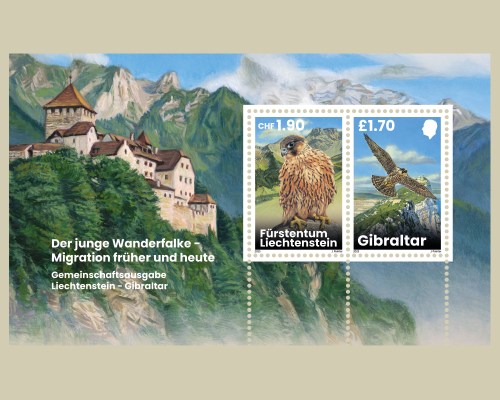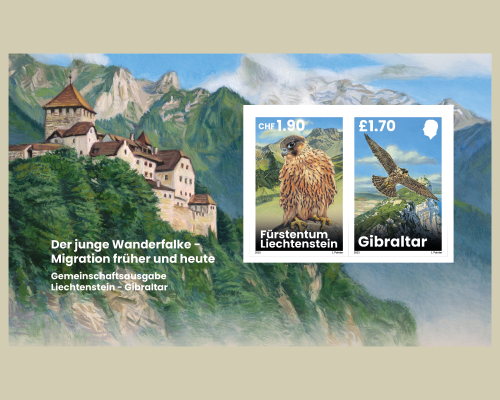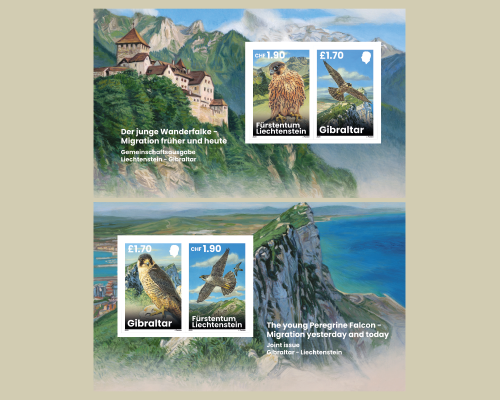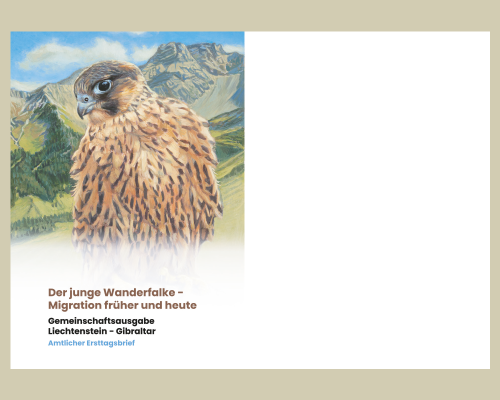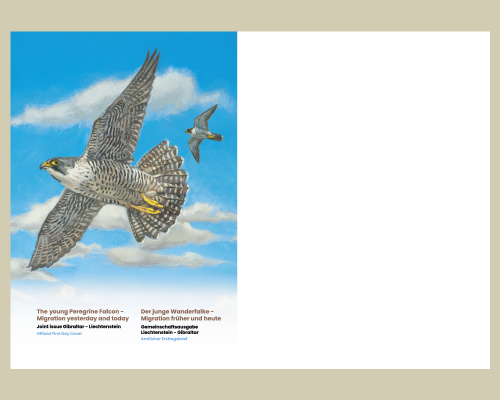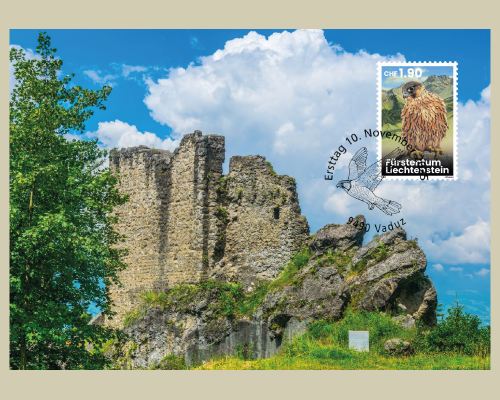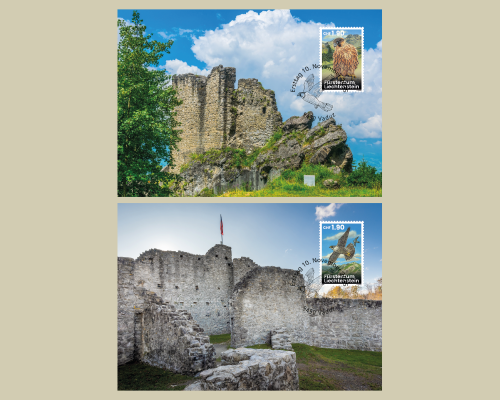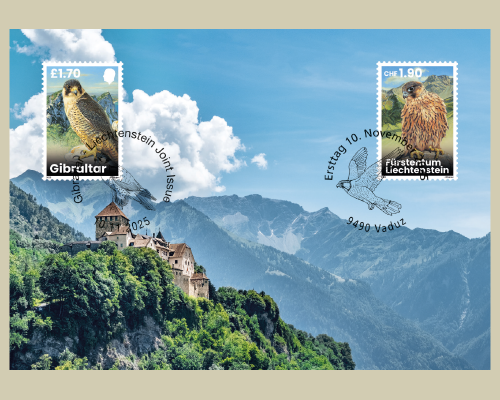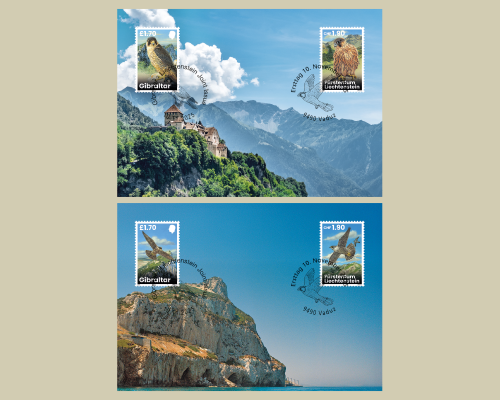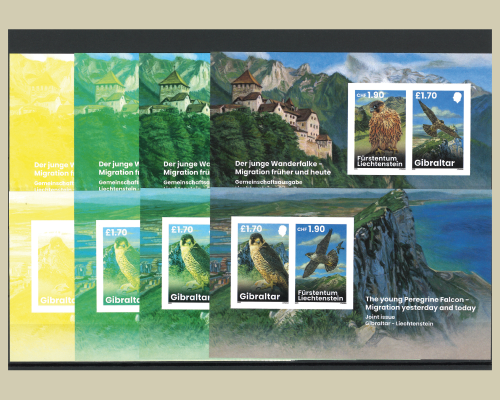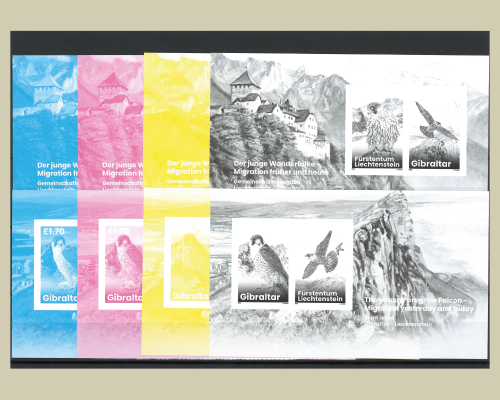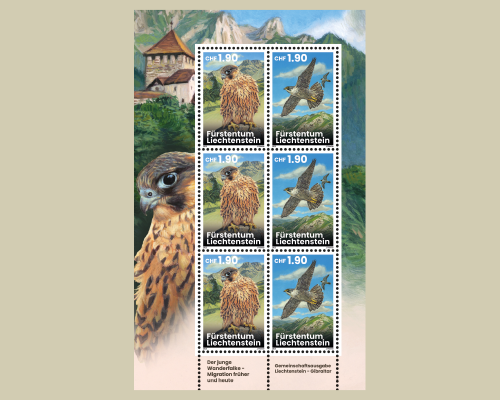Young Peregrine Falcons – now and then
Peregrine falcons as witnesses to natural change
Two countries, one story: Joint Issue Liechtenstein - Gibraltar
The peregrine falcon is one of the fastest birds in the world – and also a silent witness to climate change. Young falcons used to migrate south in winter, stopping off in Gibraltar, but warmer winters now allow them to remain in the Alpine region. As part of a joint issue with the Royal Gibraltar Post Office, we are dedicating a special block of two stamps to the falcon. The “Peregrine Falcon juvenile” stamp (face value CHF 1.90) shows the young peregrine falcon before its departure to the south. The “Peregrine Falcon adult” motif (face value CHF 1.90) shows two peregrine falcons flying over the Liechtenstein Alps after their return.
A special joint philatelic issue as a cross-border project about a changing world.


Falconry – hunting with birds of prey, especially falcons – is one of the oldest forms of hunting known to mankind. It originated around 4,000 years ago in the steppes of Asia, where nomadic peoples used falcons and eagles to hunt wild animals. This tradition was already mentioned in China around 2205 BC. Caravans and conquests brought falconry to Persia, Arabia and finally to Europe, where it flourished especially in the Middle Ages. Emperor Frederick II of Hohenstaufen (1194–1250) shaped European falconry by writing the famous book ‘De Arte Venandi Cum Avibus’ (in English, ‘On the Art of Hunting with Birds’), which is still considered a fundamental work today.
Falconry became a status symbol among the nobility, with each class having its own preferred bird species – for example, emperors and kings used the gyrfalcon, while the lower nobility and knights used the peregrine falcon. With the spread of firearms, falconry lost its importance, but it experienced a revival in the 20th century due to interest in natural history and species conservation.
Falcon Facts - regional to international
Which falcons are native to the Principality of Liechtenstein?
The kestrel (Falco tinnunculus) is by far the most common species of falcon in Central Europe and is also very widespread in Liechtenstein. It is adaptable, inhabits a variety of habitats and is often seen in cultivated landscapes, towns and villages.
The peregrine falcon (Falco peregrinus) is one of the best-known species of falcon and is considered the fastest bird in the world: it can reach speeds of up to 390 km/h in a dive. Distinctive features include its powerful body, long, pointed wings and a clearly recognisable black beard stripe on its head. Adult birds are dark blue-grey on top and white with black cross-markings on the underside.
The Eurasian hobby (Falco subbuteo) is rare in Liechtenstein, but has been recorded.
What makes falcons so special?
Falcons are fast, agile hunters with long, pointed wings and short, powerful beaks.
Unlike birds of prey, falcons do not kill their prey with their talons, but with a special ‘falcon tooth’ on their upper beak, which severs the prey's neck.
Falcons usually hunt in flight and are known for their high speed; the peregrine falcon is considered the fastest animal in the world in a dive..
Falcons are adaptable and inhabit a variety of habitats, from open landscapes to urban areas.
The different species of falcons differ in size, hunting behaviour and preferred prey: the hobby, for example, often hunts insects and small birds in the air, while the kestrel prefers small mammals and often hunts by hovering in the air.
The influence of falcons on native birds
Prey spectrum: Peregrine falcons feed mainly on small to medium-sized birds. They do not prefer any particular species, but rather prey on the most common birds available.
Competition with other species: There is some overlap in the prey of birds of prey such as the goshawk. However, their hunting techniques differ, which is why falcons do not have a negative impact on the populations of birds of prey.
Adaptation to food supply: Peregrine falcons flexibly adapt their prey to the available supply and can hunt other species more frequently when changes occur.
Role in the ecosystem: Falcons are important regulators in the ecosystem and naturally exert pressure on their prey. An intact falcon population is a sign of a healthy ecosystem.
When a falcon appears, it often becomes quiet around it because songbirds and other smaller birds instinctively fall silent so as not to attract attention. In this way, they try to escape the attention of the predator and increase their chances of survival.
The migratory behaviour of falcons
Falcons are migrating south less and less in winter because living conditions in their winter quarters and breeding grounds have changed. The main reason for this is climate change: winters in Central Europe, including Liechtenstein, are becoming milder, which means that falcons such as kestrels and peregrine falcons can find enough food even in the cold season and are no longer forced to migrate to warmer regions.
Other factors include:
Changes in land use and the availability of prey (e.g. mouse populations) enable falcons to remain in their breeding grounds even in winter.
Cities offer additional food sources and mild microclimates, so falcons are increasingly becoming resident birds.
In some species, such as the hobby, the willingness to migrate remains high, but here too there are indications that individual birds are travelling shorter distances or returning earlier when conditions are favourable.
Experience falcons and birds of prey in the wild in Liechtenstein
Liechtenstein's natural environment is home to many impressive bird species. From the nimble kestrel to the buzzard and the proud red kite to the king of the skies, the golden eagle – some of Europe's most spectacular birds live here. Occasionally, you may even spot bearded vultures or griffon vultures. Observing these unique animals in their natural environment, hunting and breeding, is always a special experience.
Liechtenstein Ornithological Association (in German)The shortening or elimination of migration is therefore an adaptation to changing environmental conditions, in particular milder winters and better food availability in Central Europe.
Regional differences
Falcons are found on every continent except Antarctica. The greatest diversity of species is found in Central and South America and in Africa. In Central Europe, kestrels, hobby falcons and peregrine falcons are particularly common. In the tropics, there are smaller species and specialised forest falcons, while larger species dominate in cold or temperate climates.
The habitat, prey and hunting techniques vary from region to region. For example, desert falcons in Asia hunt over wide open spaces, while kestrels in Central Europe often breed in cultivated land and even in cities. In East Africa, there are both sedentary and migratory falcon species, which contributes to the diversity.
Conclusion: Falconry is a tradition dating back thousands of years, which has firmly established falcons in cultural history. Several species of falcons live in Liechtenstein, in particular the peregrine falcon, which is also very widespread worldwide and is characterised by its enormous adaptability. The characteristics of falcons vary depending on the region, climate and species.
Differences between European and Arabian falcons
In Europe, the main species are the peregrine falcon (Falco peregrinus), kestrel (Falco tinnunculus), hobby (Falco subbuteo), saker falcon (Falco cherrug), lanner falcon (Falco biarmicus) and gyrfalcon (Falco rusticolus). They are adapted to different habitats such as forests, open fields, steppes and cliffs.
European falcons show greater diversity in colouring, size and hunting techniques, as they are widespread from the boreal north to the Mediterranean climate of Europe.
In Europe, falcons have historically served as hunting birds at court and enjoyed a high status, especially in the Middle Ages. In modern times, species conservation and falconry as a hobby and breeding are at the forefront.
The Lanner falcon (Falco biarmicus), the saker falcon (Falco cherrug) and the peregrine falcon are typically found on the Arabian Peninsula.
Falcons from the Arabian Peninsula are often slightly lighter in colour and better adapted to warm, open, semi-desert-like areas. They usually have long, narrow wings, which enable them to fly fast and hunt over large areas.
In the Arab world, falcons are still an important status symbol today. Falconry is deeply rooted in the culture and is seen as a symbol of nobility and skill. A well-trained falcon can cost a very high price.
Falcons fascinate us with their elegance in flight, their keen senses and their specialised hunting techniques.
As status symbols, they remain central animals in modern falconry today.
An unforgettable experience with birds of prey in the heart of the Alps: the Galina Falconry in Malbun
Galina Falconry in Malbun, Liechtenstein, has been thrilling visitors for many years with unique experiences involving majestic birds of prey and the traditional art of falconry. Norman Vögeli is both a passionate falconer and hotelier. His spectacular flight shows are an experience for the whole family, allowing the audience to see the animals up close.
The animals at Galina Falconry include:
- Golden eagles
- Falcons
- Eagle owls
- Hawks (especially Harris hawks)
- Buzzards
- Ravens

